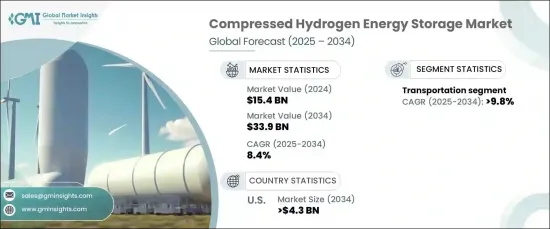
세계 압축 수소 에너지 저장 시장은 2024년 154억 달러로 평가되었고, 2025년부터 2034년까지 연평균 복합 성장률(CAGR) 8.4%로 성장할 것으로 예측됩니다.
지속가능한 에너지 솔루션에 대한 수요 증가는 탈 탄소 전략에서 중요한 요소로 수소 채용을 촉진하고 있으며, 특히 중공업이나 장거리 수송 등 전기의 실행 가능성이 낮은 분야에서의 도입이 진행되고 있습니다. 압축 수소 저장은 수소를 효율적으로 취급하고 제로 방출 에너지 시스템에서의 사용을 가능하게 하는데 필수적입니다.

세계 정부와 기업들이 야심찬 기후 변화 목표를 세우고 있으며 수소 인프라와 기술 투자에 박차를 가하고 있습니다. 압축 수소는 연료전지 차량, 송전망 안정화, 백업 전원 시스템 등 다목적 용도를 제공합니다. 유럽, 북미, 아시아태평양 등 지역에서는 지원 정책과 재정적 인센티브로 수소 저장 시스템의 도입이 급속히 진행되고 있습니다. 세계의 에너지 전환 전략에서 수소의 역할은 압축 수소 저장을 청정 에너지 생태계의 필수 요소로 삼고 있습니다.
| 시장 범위 | |
|---|---|
| 시작연도 | 2024년 |
| 예측연도 | 2025년-2034년 |
| 시작금액 | 154억 달러 |
| 예측 금액 | 339억 달러 |
| CAGR | 8.4% |
시장은 용도별로 운송용, 산업용, 거치형, 기타 용도로 구분됩니다. 이 중 운송 부문은 2034년까지 연평균 복합 성장률(CAGR) 9.8%를 나타낼 것으로 예상됩니다. 배터리 전기자동차에 비해 항속 거리가 길고 연료 보급이 빠른 연료전지 전기자동차(FCEV)의 인기가 높아지고 있는 것이 주된 성장 요인입니다. 깨끗한 운송 솔루션을 홍보하기 위한 규제 및 인센티브는 시장 확대를 더욱 가속화하고 있습니다.
미국의 압축 수소 에너지 저장시장은 2034년까지 43억 달러를 창출할 것으로 예상되고 있으며, 이는 청정에너지에 대한 대처와 탈탄소화에 대한 대처에 국가가 주력하고 있는 요인이 되고 있습니다. 운송 부문, 특히 수소 자동차의 도입은 시장 성장에 매우 중요한 역할을 합니다. 또한 산업 부문에서도 깨끗한 대체 에너지로 수소에 대한 관심이 높아지고 있습니다. 고압 저장 기술과 압축 시스템의 진보가 효율을 향상시켜 보급을 뒷받침하고 있습니다.
수소가 지속가능한 에너지 시스템의 핵심으로 지속적으로 성장하면서 신뢰성 있고 효율적인 저장 솔루션의 필요성이 가장 중요해지고 있습니다. 압축 수소 저장은 청정 에너지에 대한 수요 증가를 지원하고 다양한 응용 분야에서 가용성을 보장하는 데 적합합니다. 지속적인 혁신과 인프라 확대로 시장이 크게 성장하고 세계의 지속가능성 목표 달성에 수소의 역할을 강화하는 태세가 갖추어지고 있습니다.
The Global Compressed Hydrogen Energy Storage Market was valued at USD 15.4 billion in 2024 and is projected to grow at a CAGR of 8.4% during 2025- 2034. The rising demand for sustainable energy solutions is driving the adoption of hydrogen as a key component in decarbonization strategies, especially in sectors where electrification is less viable, such as heavy industries and long-haul transportation. Compressed hydrogen storage is critical for efficient hydrogen handling, enabling its use in zero-emission energy systems.

Governments and corporations worldwide are committing to ambitious climate goals, spurring investments in hydrogen infrastructure and technologies. Compressed hydrogen offers versatile applications in fuel cell vehicles, grid stabilization, and backup power systems. Regions like Europe, North America, and Asia-Pacific are witnessing rapid adoption of hydrogen storage systems due to supportive policies and financial incentives. Hydrogen's role in global energy transition strategies has positioned compressed hydrogen storage as an essential element of the clean energy ecosystem.
| Market Scope | |
|---|---|
| Start Year | 2024 |
| Forecast Year | 2025-2034 |
| Start Value | $15.4 Billion |
| Forecast Value | $33.9 Billion |
| CAGR | 8.4% |
The market is segmented by application into transportation, industrial, stationary, and other uses. Among these, the transportation sector is expected to register a CAGR of 9.8% through 2034. The increasing popularity of fuel cell electric vehicles (FCEVs), driven by their longer range and faster refueling capabilities compared to battery-electric vehicles, is a key growth factor. Regulatory measures and incentives aimed at promoting clean transportation solutions are further accelerating market expansion.
U.S. compressed hydrogen energy storage market is anticipated to generate USD 4.3 billion through 2034, fueled by the nation's focus on clean energy initiatives and decarbonization efforts. The transportation sector, particularly the adoption of hydrogen-powered vehicles, plays a pivotal role in market growth. Additionally, industrial sectors are increasingly turning to hydrogen as a cleaner energy alternative. Advances in high-pressure storage technologies and enhanced compression systems are improving efficiency and driving adoption.
As hydrogen continues to emerge as a cornerstone of sustainable energy systems, the need for reliable and efficient storage solutions becomes paramount. Compressed hydrogen storage is well-positioned to support the growing demand for clean energy, ensuring its availability across various applications. With ongoing innovation and expanding infrastructure, the market is poised for significant growth, reinforcing hydrogen's role in achieving global sustainability goals.